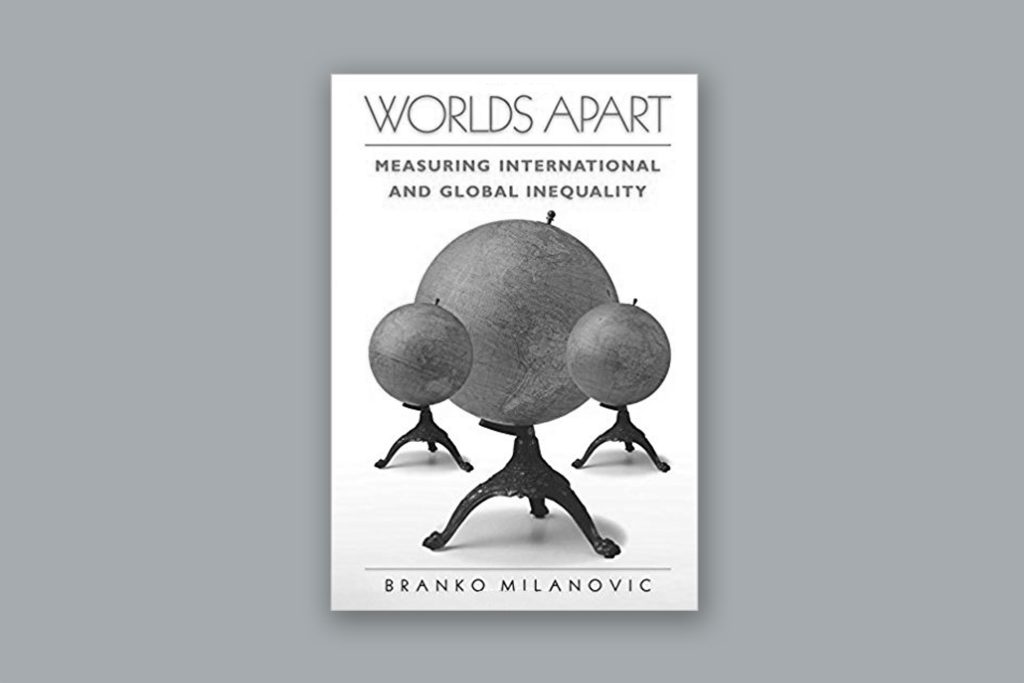The Rich Get Richer, The Poor Get Squat
Review of Branko Milanovic's Worlds Apart: Measuring International and Global Inequality (Princeton: 2005)
Global economic inequality isn’t something that grabs a lot of headlines. And a book on the subject surely doesn’t seem like gripping summertime reading. But don’t go away. This subject is critically important, and this particular book is extraordinary.
The debate among economists and other experts over capitalism’s role in widening or narrowing the income gap between the world’s winners and losers—or, more simply, between the world’s rich and poor—is nothing short of raucous (yes, economists can be raucous). The stakes are as high as they get. f people around the world come to perceive that today’s globalized capitalism is making the already rich vastly richer, while it’s simultaneously leaving a large fraction of the world’s population behind, then it will lose much of its moral standing as a set of principles for ordering our social and economic lives. And any social system that loses its moral standing—its legitimacy, in the jargon of social scientists—is a target for rebellion.
As so often happens in high-stakes debates when there’s abundant evidence to support widely varied positions, people point to evidence that satisfies their temperamental bias. In this case, optimists focus on the soaring standard of living in countries like Chile, Malaysia, and Taiwan; in the booming commercial zones of coastal China; and in the high-tech cities of southern India. Pessimists, on the other hand, focus on the chronic economic crisis in Africa and stagnation in much of Latin America. But the matter of income gaps and their causes is extraordinarily complex, so the evidence needs painstaking interpretation.
Branko Milanovic’s new book does the job, and the results are fascinating. A Lead Economist at the World Bank, and recently a senior associate with the Carnegie Endowment for International Peace, Milanovic has written probably the most comprehensive, thorough, and balanced assessment yet of global inequality. And, for the most part, it shows the pessimists are right. Milanovic interprets the data with great care and understates his conclusions, but in the end his book is an indictment of today’s global economic order as, on balance, an abject moral failure.
The statistics describing the gap between rich and poor people on Earth are truly breathtaking. According to a recent report from the World Bank, in 2001 about 1.1 billion people, or one-fifth of the population of the world’s poor countries, lived on less than what one dollar a day would buy in the United States. About 2.7 billion people, or over half the developing world’s population, lived on less than two dollars a day. In 2004, says the UN’s Food and Agriculture Organization, 852 million people faced chronic hunger, up 15 million from the previous year. And in the same year, according to UNICEF, one billion children—or nearly half the children in the world—were severely deprived. Over 600 million children didn’t have adequate shelter, and every day four thousand died because of dirty water or poor sanitation.
Meanwhile, at the other end of the spectrum, in 2004 the world had 587 billionaires with a combined wealth of $1.9 trillion—equivalent to nearly 20 percent of the annual economic output of the United States. If liquidated, this wealth would have been sufficient to hire the poorest third of the world’s workers for a whole year—a labor force of nearly one billion people. The capacity of the world’s wealthiest people to buy the labor of its poorest is probably the best measure of humankind’s economic disparities, and never before have so few had the ability to command the labor of so many.
But are these disparities getting worse? Here we have to tread carefully, because the question leads us into a theoretical and statistical minefield. Milanovic begins the journey by distinguishing among three types of inequality: inequality between countries’ average incomes (measured in terms of GDP per capita), between average incomes weighted by the countries’ populations, and between individuals. This tripartite distinction is critically important, because each measure of inequality tells us something distinct. Let’s start with the first.
Orthodox economic theory says that rich and poor countries should eventually converge to similar levels of per capita income, because investment should flow from rich countries, where capital is abundant and returns are limited, to poor countries, where capital is scarce and returns are much higher. If convergence is happening, then GDP in low-income countries should generally grow faster than in high-income countries, and over time the incomes of people in poor countries should reach the level of incomes in rich countries, at which point the distinction between poor and rich will disappear.
Economists have known for some time that, for the most part, convergence isn’t happening. Many of today’s poorest countries have GDP growth rates far below those of the richest countries. And, if we look back over a century or more, inequality between incomes in poor countries and those in rich countries has widened. Such inequality, says former IMF Deputy Managing Director Stanley Fischer, “appears to have been increasing for at least four hundred years.” Milanovic concurs. By his analysis, this kind of inequality has more than doubled since 1820, with only a brief pause in the trend between World War I and World War II.
But his most striking finding concerns the polarization of the world’s countries into rich and poor clubs: relative to the rich, almost all the middle income countries in 1960 dropped into the ranks of the poor by 2000, and the club of rich countries became almost exclusively Western. “While in the year 1960,” he writes, “there were forty-one rich countries—nineteen of them non- Western—in 2000, there were only thirty-one rich countries, and only nine of them were non-Western. None of the African countries (except for Mauritius) and none of the Latin American and Caribbean countries (except for the Bahamas) were left among the rich. Latin America and the Caribbean, probably for the first time in 200 years, had no country that was richer than the poorest West European country.” And once you’re in the poor club, history shows that it’s almost impossible to get out. “Unless there is a remarkable discontinuity with the patterns of development that have lasted during the past half-century (and possibly longer), the likelihood of escaping from the bottom rung is almost negligible.”
But many of these countries that have fallen behind have relatively small populations or are marginal in the world economy. Upbeat economists note that the two really big countries—China and India—are doing exceptionally well, with per capita income growth rates that are two to four times higher than those of rich countries. And, they say, when we weight countries’ incomes by their populations, which gives the economic success of China and India its due, we find that global income inequality is declining.
Milanovic acknowledges that, according to this measure, global inequality has indeed declined, although only for the last twenty years or so. Yet he argues that this measure is ultimately not very satisfactory. Among other things, it doesn’t gauge inequality between individuals within countries. If we really want to know what’s happening with global inequality, including inequality both between and within countries, we should measure inequality between all the world’s individuals, as if national boundaries suddenly vanished, allowing us to examine the income of each person as a member of a single global population.
In the last decade, Milanovic has pioneered exactly this kind of measure, and in this book he presents his latest results. Exploiting the World Bank’s vast database on household incomes and expenditures—a database that details the economic behaviour of individual people and families in countries that together include over 84 percent of the world’s population—Milanovic finds that inequality between individuals stayed roughly constant, and extremely high, in the last two decades of the twentieth century. Between 1988 and 1993, inequality increased mainly because average incomes in rural Asia—especially in the still-immense rural populations of China, India, and Bangladesh—grew much more slowly than incomes in rich countries. Inequality increased, too, because of a rapidly widening gap between rural and urban incomes in China. Between 1993 and 1998, the overall inequality trend reversed itself slightly: while the gap between rural and urban incomes in China continued to grow, the gap between rural incomes in India and China and incomes in rich countries shrank slightly.
So upbeat assessments of the world inequality trend, based on population-weighted measures, are wrong. Inequality between the world’s rich and poor people has been rising for a very long time and has stayed high in recent decades. To the extent that there has been improvement in the population-weighted inequality statistics, it has been entirely due to China’s spectacular growth since the 1970s. But when we look at inequality between individuals, we find that widening inequalities inside China and India have counterbalanced the gains from China’s overall growth. We also find, definitively, that we now live in the world without a middle class: over 77 percent of the world’s people are poor (with a per capita income below the Brazilian average), while nearly 16 percent are rich (with incomes above the Portuguese average), which leaves less than 7 percent in the middle.
This is not a prescription for a stable global polity. Milanovic points out that political theorists going back to Aristotle have argued that a large middle class is key to civil peace. The more we live in a truly global society—intimately connected by fiber-optic cables, air travel, and trade—the more the absence of a world middle class matters. And the more the huge income differences among us matter too, because people care not just about their absolute level of income but also about their relative position in the overall income distribution. “Globalization must, by changing the reference point upward,” Milanovic concludes, “make people in poor countries feel more deprived.”
Worlds Apart has too many tables, graphs, and formulas for lazy summertime reading. Yet Branko Milanovic makes a difficult subject remarkably accessible. His expertise and intellectual integrity inform every page. And underneath all the technical apparatus of argument and analysis, one senses his passion for the cause of reducing inequality—even if only a little—and his perplexity at finding himself one very lucky human being among billions who aren’t so fortunate.

Topics
Economics
